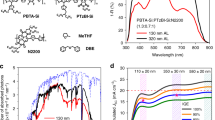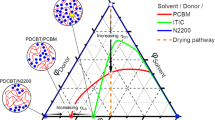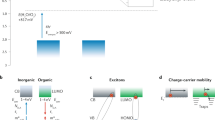Abstract
Photoexcited electron transfer between donor and acceptor molecular semiconductors provides a method of efficient charge generation following photoabsorption, which can be exploited in photovoltaic diodes1,2,3. But efficient charge separation and transport to collection electrodes is problematic, because the absorbed photons must be close to the donor–acceptor heterojunction, while at the same time good connectivity of the donor and acceptor materials to their respective electrodes is required. Mixtures of acceptor and donor semiconducting polymers3,4 (or macromolecules5) can provide phase-separated structures which go some way to meeting this requirement, providing high photoconductive efficiencies. Here we describe two-layer polymer diodes, fabricated by a lamination technique followed by controlled annealing. The resulting structures provide good connectivity to the collection electrodes, and we achieve a short-circuit photovoltaic quantum efficiency of up to 29% at optimum wavelength, and an overall power conversion efficiency of 1.9% under a simulated solar spectrum. Given the convenience of polymer processing, these results indicate a promising avenue towards practical applications for such devices.
This is a preview of subscription content, access via your institution
Access options
Subscribe to this journal
Receive 51 print issues and online access
$199.00 per year
only $3.90 per issue
Buy this article
- Purchase on Springer Link
- Instant access to full article PDF
Prices may be subject to local taxes which are calculated during checkout





Similar content being viewed by others
References
Tang, C. W. Two-layer organic photovoltaic cell. Appl. Phys. Lett. 48, 183–185 (1986).
Halls, J. J. M., Pichler, K., Friend, R. H., Moratti, S. C. & Holmes, A. B. Exciton diffusion and dissociation in a poly(p-phenylenevinylene)/C60heterojunction photovoltaic cell. Appl. Phys. Lett. 68, 3120–3122 (1996).
Halls, J. J. M.et al. Efficient photodiodes from interpenetrating polymer networks. Nature 376, 498–500 (1995).
Yu, G. & Heeger, A. J. Charge separation and photovoltaic conversion in polymer composites with internal donor-acceptor heterojunctions. J. Appl. Phys. 78, 4510–4515 (1995).
Yu, G., Gao, J., Hummelen, J. C., Wudl, F. & Heeger, A. J. Polymer photovoltaic cells-enhanced efficiencies via a network of internal donor-acceptor heterojunctions. Science 270, 1789–1791 (1995).
Burroughes, J. H.et al. Light-emitting diodes based on conjugated polymers. Nature 347, 539–541 (1990).
Willander, M., Assadi, A. & Svensson, C. Polymer-based devices their function and characterization. Synth. Met. 57, 4099–4104 (1993).
Partridge, A. C., Harris, P. & Andrews, M. K. High-sensitivity conducting polymer sensors. Analyst 121, 1349–1353 (1996).
Yu, G. & Heeger, A. J. High efficiency photonic devices made with semiconducting polymers. Synth. Met. 85, 1183–1186 (1987).
Friend, R. H.et al. Electronic excitations in luminescent conjugated polymers. Solid State Commun. 102, 249–258 (1997).
Tada, K., Onoda, M., Zakhidov, A. A. & Yoshino, K. Characteristics of poly(p-pyridyl vinylene)/poly(3-alkylthiophene) heterojunction photocell. Jpn. J. Appl. Phys. Pt2-Lett. 36, L306–L309 (1997).
Takahashi, K.et al. Enhanced quantum yield in porphyrin/electron-donor double-layer solar cells. Solar Energy Mater. Solar Cells 45, 127–139 (1997).
Yoshino, K., Tada, K., Fujii, A., Conwell, E. M. & Zakhidov, A. A. Novel photovoltaic devices based on donor-acceptor molecular and conducting polymer systems. IEEE Trans. Electron. Devices 44, 1315–1324 (1997).
Roman, L. S., Andersson, M. R., Yohannes, T. & Inganäs, O. Photodiode performance and nanostructure of poly(thiophene)/C60blends. Adv. Mater. 9, 1164–1168 (1997).
Yang, C. Y. & Heeger, A. J. Morphology of composites of semiconducting polymers mixed with C60. Synth. Met. 83, 85–88 (1996).
Moratti, S. C.et al. High electron-affinity polymers for LEDs. Synth. Met. 71, 2117–2120 (1995).
Greenham, N. C., Moratti, S. C., Bradley, D. D. C., Friend, R. H. & Holmes, A. B. Efficient polymer-based light-emitting diodes based on polymers with high electron affinities. Nature 365, 628–630 (1993).
Baigent, D. R.et al. Light-emitting diodes fabricated with conjugated polymers—recent progress. Synth. Met. 67, 3–10 (1994).
Andersson, M. R.et al. Electroluminescence from substituted poly(thiophenes)—from blue to near-infrared. Macromolecules 28, 7525–7529 (1995).
Berggren, M.et al. Thermal control of near-infrared and visible electroluminescence in alkyl-phenyl substituted polythiophenes. Appl. Phys. Lett. 65, 1489–1491 (1994).
Andersson, M. R.et al. Regioselective polymerization of 3-(4-octylphenyl)thiophene with FeCl3. Macromolecules 27, 6503–6506 (1994).
de Mello, J. C., Wittmann, H. F. & Friend, R. H. An improved experimental determination of external photoluminescence quantum efficiency. Adv. Mater. 9, 230–232 (1997).
Granström, M.et al. Self-organizing polymer films—a route to novel electronic devices based on conjugated polymers. Supramol. Sci. 4, 27–34 (1997).
O'Regan, B. & Grätzel, M. Alow-cost, high-efficiency solar cell based on dye-sensitized colloidal TiO2films. Nature 353, 737–740 (1991).
Acknowledgements
Financial support from the Engineering and Physical Sciences Research Council, the European Commission (TMR Marie Curie fellowship and TMR Network SELOA), and from CNPq, Brazilian government, is gratefully acknowledged.
Author information
Authors and Affiliations
Corresponding author
Rights and permissions
About this article
Cite this article
Granström, M., Petritsch, K., Arias, A. et al. Laminated fabrication of polymeric photovoltaic diodes. Nature 395, 257–260 (1998). https://doi.org/10.1038/26183
Received:
Accepted:
Issue Date:
DOI: https://doi.org/10.1038/26183
This article is cited by
-
Synthesis and application of green solvent dispersed organic semiconducting nanoparticles
Nano Research (2023)
-
Effect of illumination on electrical characteristics of Au/Mn-complex/n-Si photodiode structures
Journal of Materials Science: Materials in Electronics (2022)
-
Adduct-based p-doping of organic semiconductors
Nature Materials (2021)
-
Comparison of TiO2 and ZnO electron selective layers on the inverted-type polymer solar cells
Polymer Bulletin (2021)
-
Synthesis and Photovoltaic Properties of Benzotrithiophene-Based Polymer/Non-fullerene Solar Cells
Journal of Electronic Materials (2021)
Comments
By submitting a comment you agree to abide by our Terms and Community Guidelines. If you find something abusive or that does not comply with our terms or guidelines please flag it as inappropriate.



